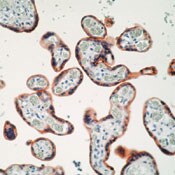GR36
Anti-Insulin Receptor (β-Subunit) Mouse mAb (CT-3)
liquid, clone CT-3, Calbiochem®
biological source
mouse
Quality Level
antibody product type
primary antibodies
clone
CT-3, monoclonal
form
liquid
contains
≤0.1% sodium azide as preservative
species reactivity
mouse, human, rat
manufacturer/tradename
Calbiochem®
storage condition
OK to freeze
avoid repeated freeze/thaw cycles
isotype
IgG1
shipped in
wet ice
storage temp.
2-8°C
General description
Purified mouse monoclonal antibody gernerated by immunizing BALB/c mice with the specified immunogen and fusing splenocytes with NS1 mouse myeloma cells. Recognizes the ~95 kDa the β-subunit of insulin receptor.
Recognizes the ~95 kDa the β-subunit of insulin receptor in IM9 cells, placenta, and fetal liver tissue.
This Anti-Insulin Receptor (β-Subunit) Mouse mAb (CT-3) is validated for use in Frozen Sections, Immunoblotting, IP, Paraffin Sections for the detection of Insulin Receptor (β-Subunit).
Immunogen
Human
a recombinant protein consisting of the C-terminal 100 amino acids of the β-subunit of human insulin receptor fused to GST
Application


Frozen Sections (1:50-1:100)
Immunoblotting (1:200-1:400)
Immunoprecipitation (not recommended)
Paraffin Sections (1:50-1:100, pressure cooker pre-treatment required)
Packaging
Please refer to vial label for lot-specific concentration.
Physical form
In 10 mM PBS, 0.2% BSA, pH 7.4.
Preparation Note
Following initial use, aliquot and freeze (-20°C) for long-term storage. Avoid freeze/thaw cycles. Centrifuge the contents of the vial containing the antibody before use to remove any solution that may have accumulated around or under the cap of the vial during shipment or storage.
Analysis Note
Positive Control
IM-9 lymphocyte cells or placenta or liver tissue
IM-9 lymphocyte cells or placenta or liver tissue
Other Notes
Grigorescu, F., et al. 1987. J.Clin. Endocrinol. Metab.64, 549.
Hari, J. and Roth, R.A. 1987. J. Biol. Chem.262, 15341.
Rosen, O.M. 1987. Science237, 1452.
Morgan, D.O., et al. 1986. Proc. Natl. Acad. Sci. USA83, 328.
Morgan, D.O. and Roth, R.A. 1986. Biochemistry25, 1364.
White, M.F. and Kahn, C.R. 1986. The Enzymes17, 247.
Ganguly, S., et al. 1985. In Current Topics in Cellular Regulation, Academic Press 27, 83.
Grunberger, G., et al. 1984. Science223, 932.
Hari, J. and Roth, R.A. 1987. J. Biol. Chem.262, 15341.
Rosen, O.M. 1987. Science237, 1452.
Morgan, D.O., et al. 1986. Proc. Natl. Acad. Sci. USA83, 328.
Morgan, D.O. and Roth, R.A. 1986. Biochemistry25, 1364.
White, M.F. and Kahn, C.R. 1986. The Enzymes17, 247.
Ganguly, S., et al. 1985. In Current Topics in Cellular Regulation, Academic Press 27, 83.
Grunberger, G., et al. 1984. Science223, 932.
No cross-reactivity with IGF receptors. Will stain IM-9 lymphocyte cells as well as placenta and liver tissue. This antibody is also useful for tyrosine kinase assays for antibody mediated capture on microwell plates. Antibody should be titrated for optimal results in individual systems.
Legal Information
CALBIOCHEM is a registered trademark of Merck KGaA, Darmstadt, Germany
Disclaimer
Toxicity: Standard Handling (A)
Not finding the right product?
Try our Product Selector Tool.
Storage Class Code
11 - Combustible Solids
WGK
WGK 1
Flash Point(F)
Not applicable
Flash Point(C)
Not applicable
Certificates of Analysis (COA)
Search for Certificates of Analysis (COA) by entering the products Lot/Batch Number. Lot and Batch Numbers can be found on a product’s label following the words ‘Lot’ or ‘Batch’.
Already Own This Product?
Find documentation for the products that you have recently purchased in the Document Library.
Martin B Oleksiewicz et al.
Journal of applied toxicology : JAT, 31(4), 329-341 (2010-10-12)
We compared mitogenicity and intracellular signalling by human insulin and the AspB10 (X-10) human insulin analogue in MCF-7 human mammary adenocarcinoma cells. By flow analysis of phosphorylated histone H3 or cell cycle distributions, insulin and X-10 were mitogenic at physiologically
Jennifer H Law et al.
Cancer research, 68(24), 10238-10246 (2008-12-17)
Drugs that target the insulin-like growth factor-I receptor (IGF-IR) and/or insulin receptor (IR) are currently under investigation for a variety of malignancies including breast cancer. Although we have previously reported that IGF-IR expression in primary breast tumors is common, the
Raju V S Rajala et al.
The Journal of biological chemistry, 277(45), 43319-43326 (2002-09-06)
Recently, we have shown that phosphoinositide 3-kinase (PI3K) in bovine rod outer segment (ROS) is activated in vitro by tyrosine phosphorylation of the C-terminal tail of the insulin receptor (Rajala, R. V. S., and Anderson, R. E. (2001) Invest. Ophthal.
R Klopfleisch et al.
Veterinary and comparative oncology, 8(4), 293-301 (2010-11-11)
Insulin receptor (INSR) or insulin-like growth factor (IGF) signalling is speculated to be involved in mammary tumour development. Expression levels of members of the insulin receptor family (INSR, IGF1R, IGF2R, GHR) and their ligands IGF1and IGF2 were quantified in macro-
Henning Hvid et al.
Journal of applied toxicology : JAT, 31(4), 312-328 (2011-01-25)
Supra-pharmacological doses of the insulin analog X10 (AspB10) increased the incidence of mammary tumors in female Sprague-Dawley rats in chronic toxicity studies, most likely via receptor-mediated mechanisms. However, little is known about the expression of the insulin receptor family in
Our team of scientists has experience in all areas of research including Life Science, Material Science, Chemical Synthesis, Chromatography, Analytical and many others.
Contact Technical Service